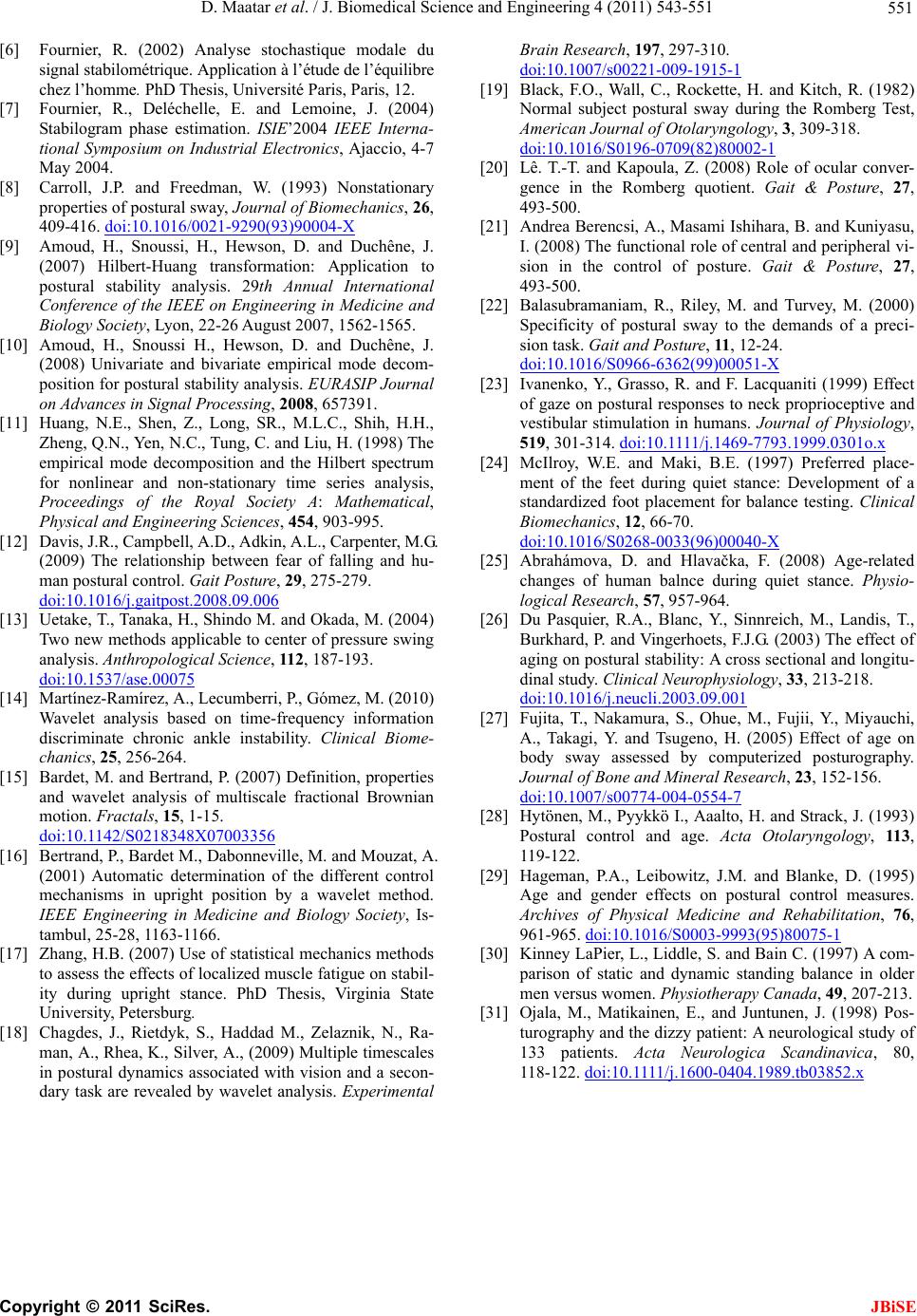
D. Maatar et al. / J. Biomedical Science and Engineering 4 (2011) 543-551 551
[6] Fournier, R. (2002) Analyse stochastique modale du
signal stabilométrique. Application à l’étude de l’équilibre
chez l’homme. PhD Thesis, Université Paris, Paris, 12.
[7] Fournier, R., Deléchelle, E. and Lemoine, J. (2004)
Stabilogram phase estimation. ISIE’2004 IEEE Interna-
tional Symposium on Industrial Electronics, Ajaccio, 4-7
May 2004.
[8] Carroll, J.P. and Freedman, W. (1993) Nonstationary
properties of postural sway, Journal of Biomechanics, 26,
409-416. doi:10.1016/0021-9290(93)90004-X
[9] Amoud, H., Snoussi, H., Hewson, D. and Duchêne, J.
(2007) Hilbert-Huang transformation: Application to
postural stability analysis. 29th Annual International
Conference of the IEEE on Engineering in Medicine and
Biology Society, Lyon, 22-26 August 2007, 1562-1565.
[10] Amoud, H., Snoussi H., Hewson, D. and Duchêne, J.
(2008) Univariate and bivariate empirical mode decom-
position for postural stability analysis. EURASIP Journal
on Advances in Signal Processing, 2008, 657391.
[11] Huang, N.E., Shen, Z., Long, SR., M.L.C., Shih, H.H.,
Zheng, Q.N., Yen, N.C., Tung, C. and Liu, H. (1998) The
empirical mode decomposition and the Hilbert spectrum
for nonlinear and non-stationary time series analysis,
Proceedings of the Royal Society A: Mathematical,
Physical and Engineering Sciences, 454, 903-995.
[12] Davis, J.R., Campbell, A.D., Adkin, A.L., Carpenter, M.G.
(2009) The relationship between fear of falling and hu-
man postural control. Gait Posture, 29, 275-279.
doi:10.1016/j.gaitpost.2008.09.006
[13] Uetake, T., Tanaka, H., Shindo M. and Okada, M. (2004)
Two new methods applicable to center of pressure swing
analysis. Anthropological Science, 112, 187-193.
doi:10.1537/ase.00075
[14] Martínez-Ramírez, A., Lecumberri, P., Gómez, M. (2010)
Wavelet analysis based on time-frequency information
discriminate chronic ankle instability. Clinical Biome-
chanics, 25, 256-264.
[15] Bardet, M. and Bertrand, P. (2007) Definition, properties
and wavelet analysis of multiscale fractional Brownian
motion. Fractals, 15, 1-15.
doi:10.1142/S0218348X07003356
[16] Bertrand, P., Bardet M., Dabonneville, M. and Mouzat, A.
(2001) Automatic determination of the different control
mechanisms in upright position by a wavelet method.
IEEE Engineering in Medicine and Biology Society, Is-
tambul, 25-28, 1163-1166.
[17] Zhang, H.B. (2007) Use of statistical mechanics methods
to assess the effects of localized muscle fatigue on stabil-
ity during upright stance. PhD Thesis, Virginia State
University, Petersburg.
[18] Chagdes, J., Rietdyk, S., Haddad M., Zelaznik, N., Ra-
man, A., Rhea, K., Silver, A., (2009) Multiple timescales
in postural dynamics associated with vision and a secon-
dary task are revealed by wavelet analysis. Experimental
Brain Research, 197, 297-310.
doi:10.1007/s00221-009-1915-1
[19] Black, F.O., Wall, C., Rockette, H. and Kitch, R. (1982)
Normal subject postural sway during the Romberg Test,
American Journal of Otolaryngology, 3, 309-318.
doi:10.1016/S0196-0709(82)80002-1
[20] Lê. T.-T. and Kapoula, Z. (2008) Role of ocular conver-
gence in the Romberg quotient. Gait & Posture, 27,
493-500.
[21] Andrea Berencsi, A., Masami Ishihara, B. and Kuniyasu,
I. (2008) The functional role of central and peripheral vi-
sion in the control of posture. Gait & Posture, 27,
493-500.
[22] Balasubramaniam, R., Riley, M. and Turvey, M. (2000)
Specificity of postural sway to the demands of a preci-
sion task. Gait and Posture, 11, 12-24.
doi:10.1016/S0966-6362(99)00051-X
[23] Ivanenko, Y., Grasso, R. and F. Lacquaniti (1999) Effect
of gaze on postural responses to neck proprioceptive and
vestibular stimulation in humans. Journal of Physiology,
519, 301-314. d oi:10.1111/j.1469-7793.1999.0301o.x
[24] McIlroy, W.E. and Maki, B.E. (1997) Preferred place-
ment of the feet during quiet stance: Development of a
standardized foot placement for balance testing. Clinical
Biomechanics, 12, 66-70.
doi:10.1016/S0268-0033(96)00040-X
[25] Abrahámova, D. and Hlavačka, F. (2008) Age-related
changes of human balnce during quiet stance. Physio-
logical Research, 57, 957-964.
[26] Du Pasquier, R.A., Blanc, Y., Sinnreich, M., Landis, T.,
Burkhard, P. and Vingerhoets, F.J.G. (2003) The effect of
aging on postural stability: A cross sectional and longitu-
dinal study. Clinical Neurophysiology, 33, 213-218.
doi:10.1016/j.neucli.2003.09.001
[27] Fujita, T., Nakamura, S., Ohue, M., Fujii, Y., Miyauchi,
A., Takagi, Y. and Tsugeno, H. (2005) Effect of age on
body sway assessed by computerized posturography.
Journal of Bone and Mineral Research, 23, 152-156.
doi:10.1007/s00774-004-0554-7
[28] Hytönen, M., Pyykkö I., Aaalto, H. and Strack, J. (1993)
Postural control and age. Acta Otolaryngology, 113,
119-122.
[29] Hageman, P.A., Leibowitz, J.M. and Blanke, D. (1995)
Age and gender effects on postural control measures.
Archives of Physical Medicine and Rehabilitation, 76,
961-965. doi:10.1016/S0003-9993(95)80075-1
[30] Kinney LaPier, L., Liddle, S. and Bain C. (1997) A com-
parison of static and dynamic standing balance in older
men versus women. Physiotherapy Canada, 49, 207-213.
[31] Ojala, M., Matikainen, E., and Juntunen, J. (1998) Pos-
turography and the dizzy patient: A neurological study of
133 patients. Acta Neurologica Scandinavica, 80,
118-122. doi:10.1111/j.1600-0404.1989.tb03852.x
C
opyright © 2011 SciRes. JBiSE